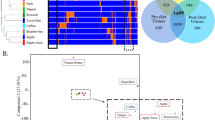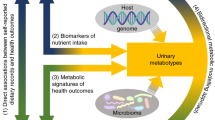Abstract
Objective: To study the variation in genistein+daidzein intake over a 6-month period and test the reliability of 24 h urinary isoflavones as a biomarker of exposure over time.
Design: Dietary genistein+daidzein intake was assessed at various time points throughout six months in 15 healthy subjects. Group 1 (n=8) followed nonsupplemented diets and Group 2 (n=7) took a 35 mg/d isoflavone supplement for 3 months and each subject provided a 24 h urine collection, validated with para-aminobenzoic acid, during weeks 7, 15 and 19. Urine was analysed for genistein and daidzein using LC-MS.
Results: Isoflavone intake in Groups 1 and 2 ranged from 0.00 to 1.1 mg/d and 0.1 to 53.1 mg/d, respectively. Urine excretion for both groups ranged from 0.20 to 9.56 mg/d. The relationship between 24 h excretion and isoflavone intake is y=0.44 × ±0.03(standard deviation) + 1.57; r=0.89, P<0.001.
Conclusion: The 24 h urinary isoflavones can be used as biomarkers of isoflavone exposure over time.
This is a preview of subscription content, access via your institution
Access options
Subscribe to this journal
Receive 12 print issues and online access
$259.00 per year
only $21.58 per issue
Buy this article
- Purchase on Springer Link
- Instant access to full article PDF
Prices may be subject to local taxes which are calculated during checkout


Similar content being viewed by others
References
Arai Y, Uehara M, Sato Y, Kimira M, Eboshida A, Adlercreutz H & Watanabe S (2000): Comparison of isoflavones among dietary intake, plasma concentration and urinary excretion for accurate estimation of phyto-oestrogen intake. J. Epidemiol. 10, 127–135.
Bingham SA & Cummings JH (1983): The use of 4 - aminobenzoic acid as a marker to validate the completeness of 24 h urine collections in man. Clin. Sci. 64, 629–635.
Griffiths K, Adlercreutz H, Boyle P, Denis L, Nicholson RI & Morton MS (1996): Nutrition and Cancer. Isis Medical Media: Oxford. pp. 1–23.
Mazur W & Adlercreutz H (1998): Natural and anthropogenic environmental oestrogens: the scientific basis for risk assessment. Naturally occurring oestrogens in food. Pure Appl. Chem. 70, 1759–1776.
Morton MS, Arisaka O, Miyake N, Morgan LD & Evans BAJ (2002): Phyto-oestrogen concentrations in serum from Japanese men and women over forty years of age. J. Nutr. 132, 3168–3171.
Nagata C (2000): Ecological study of the association between soy product intake and mortality from cancer and heart disease in Japan. Int. J. Epidemiol. 29, 832–836.
Pumford SL, Morton MS, Turkes A & Griffiths K (2002): Determination of the isoflavonoids genistein and daidzein in biological samples by Gas Chromatograhy - Mass Spectrometry. Ann. Clin. Biochem. 39, 281–292.
Ritchie MR (2003): Measurement of phyto-oestrogen content of food, plasma and urine. Derivation and validation of a biological marker for phytoestrogen intake. PhD thesis, University of St. Andrews, Scotland.
Ritchie MR, Morton MS, Deighton N, Blake A & Cummings JH (2004): ‘Plasma and urinary phytoestrogns as biomarkers of intake: validation by duplicate diet analysis. Br. J. Nutr. 91, 447–457.
Ritchie MR, Morton MS, Deighton N, Blake A, Cummings JH & CM Steel (2004b): ‘Plasma and urine concentrations of isoflavones as biomarkers of phyto-oestrogen intake following dietary soy supplementation’; Manuscript submitted to. Journal of Evidence-Based Integrative Medicine, August 2003, accepted. In press.
Schofield WN, Schofield C & James WPT (1985): Basal metabolic rate. Human Nutr.: Clin. Nutr. 39C Suppl, S1–S96.
Verkasalo PK, Appleby PN, Allen NE, Davey G, Adlercreutz H & Key TJ (2001): Soy intake and plasma concentrations of daidzein and gensitein: validity of dietary assessment among eighty British women (Oxford arm of the European Prospective Investigation into Cancer and Nutrition). Br. J. Nutr. 86, 415–421.
Author information
Authors and Affiliations
Contributions
Guarantor: M Ritchie.
Contributors: MR conducted the study and prepared the first and final draft of the manuscript, MM assisted with sample preparation and contributed to the manuscript, AT recruited and screened volunteers, referred by General Practitioners, at breast clinic and contributed to the manuscript, ND and AB carried out LC-MS analysis of samples and contributed to the manuscript, JC organised the results and contributed to the manuscript, and CS assisted with the study design and contributed to the manuscript.
Corresponding author
Rights and permissions
About this article
Cite this article
Ritchie, M., Morton, M., Thompson, A. et al. Investigation of the reliability of 24 h urine excretion as a biomarker of isoflavone exposure over time and over a wide range of isoflavone intakes. Eur J Clin Nutr 58, 1286–1289 (2004). https://doi.org/10.1038/sj.ejcn.1601963
Received:
Revised:
Accepted:
Published:
Issue Date:
DOI: https://doi.org/10.1038/sj.ejcn.1601963
Keywords
This article is cited by
-
Studies of a urinary biomarker of dietary inorganic sulphur in subjects on diets containing 1–38 mmol sulphur/day and of the half-life of ingested 34SO42−
European Journal of Clinical Nutrition (2008)



